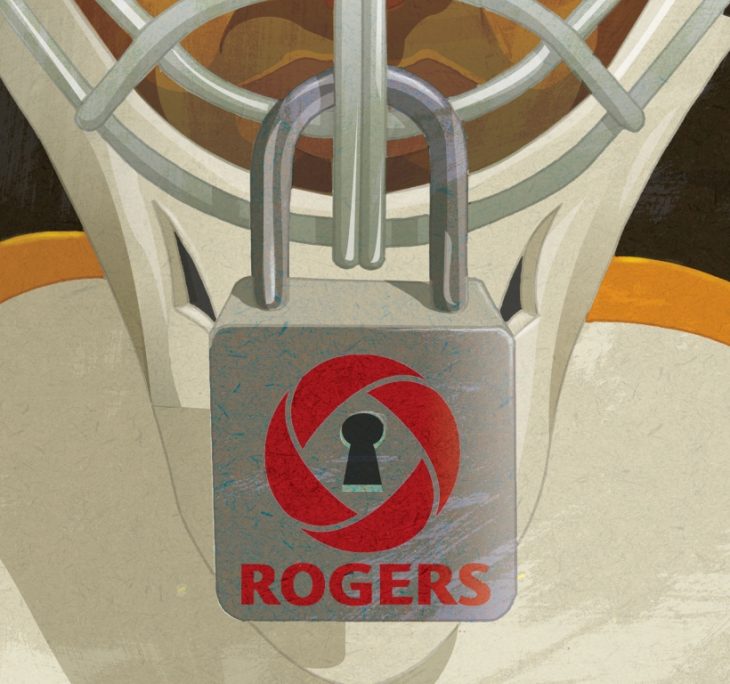
THE RECENT SPORTS CONTENT AND SPECTRUM acquisitions made by Rogers Communications falls squarely into the category of “they had better be right”.
Adding up the $3.3 billion it paid for 700 MHz spectrum in the just-finished auction, last fall’s $5.2 billion NHL rights deal and the $650 million for its portion of Maple Leafs Sports & Entertainment in 2012, that’s nearly $9.2 billion spent or committed in less than 24 months – largely due to the belief that delivering live sports (especially hockey and baseball) to any and every electronic device, any and everywhere in Canada, is the key to future growth.
It’s worth nothing that amount of money is roughly half of RCI’s total market value today of just over $18 billion. Also, it’s worth saying that spending big on assets the company deems “must-have” (especially spectrum) is something we feel the company’s founder, Ted Rogers, surely would have supported, even demanded.
The company itself tied the NHL deal and the spectrum purchase together in its own press release today entitled: “NHL FANS TO BENEFIT FROM 700MHz SPECTRUM AUCTION; Double the spectrum means double the video capacity for Rogers’ customers.”
In an interview with Rogers CTO Bob Berner and SVP video content David Purdy this afternoon, the two are obviously bullish on the company’s prospects, given the spectrum and content assets it will deploy in force and in tandem this fall (we can just imagine the marketing spend coming later this year as the 2014-15 NHL season approaches and RCI deploys its 700 MHz spectrum). Purdy said it was an “oversimplification” to say that Rogers was so determined to secure the amount of spectrum it did because of the NHL rights, but also that Berner’s spectrum auction team sought reassurance in asking him: “what do you think is going to happen in the content space? Will we free up the rights necessary to use the network?”
Purdy believes that the time is ripe for content owners to make their premium content available in as many places as possible – and that the major studios and broadcasters have finally gotten on board, or very soon will. “The NHL sees the value of having TV everywhere… in and out of home,” added Purdy. We’re well past the time where broadcasters were fearful of making their prime time content available even on the closed cable VOD platforms, something which took many years to happen.
“We went into this auction with a clear plan to win the best spectrum for our customers. There is clear demand for the ultimate video experience and it will be a big part of how we bring the NHL to hockey fans,” said Guy Laurence, president and CEO, in the press release today.
Studies have shown the amount of video watched on smartphones and tablets has grown by more than 700% since 2011 and sports has a significant share. Rogers own data shows there was a 50% spike in traffic during the final men’s Olympic hockey games as Rogers customers tuned in to catch all the action live on their phones and tablets.
“We paid what our competitors had plonked down in their last bids." – Bob Berner, Rogers
Of course, Rogers was the only company to secure two 12MHz blocks of contiguous, paired 700MHz lower band spectrum in virtually every major market across Canada, securing twice as much contiguous spectrum as Bell, Telus or any other bidders. This is an advantage now because the two contiguous blocks can be combined to deliver consistently fast downloads and uninterrupted video streaming in more places than ever before.
While many naysayers continue to repeat they believe Rogers overpaid for the spectrum, it’s not as though it was alone in its strategy, it just won the day. “We paid what our competitors had plonked down in their last bids,” noted Berner, and “we wound up with the premiere beachfront spectrum, for 20 years.”
Investing in this prime spectrum builds on Rogers’ multi-band 4G LTE spectrum strategy, which already uses both the AWS and 2600MHz spectrum bands, added the company’s release. Rogers customers will be able to use their existing LTE devices as soon as the new spectrum is deployed, which will begin during 2014.
However, neither Purdy nor Berner would offer any hints as to what its pricing plans may be. “We’re not ready to talk about those,” said Berner. But “we want to maximize consumer adoption,” added Purdy. However, the company may want its content viewed far and wide and on as many devices and by as many eyeballs as possible, but to watch hockey games from beginning to end on a smart phone or tablet on a wireless network and not Wi-Fi could end up costing a small fortune.
Estimating that a live streamed hockey game of good video quality could consume up to 4 GB of data (according to our research) it would take about four games to surpass Rogers Wireless’ biggest data offering. That is its “share everything” plan which includes unlimited talk and texting, and 15 GB/month, for $80. Data overage is $15/GB, meaning that fifth game in a month could cost $60, if viewed on the wireless net under this plan. The Toronto Maple Leafs had 15 games in March. Of course, no one believes fans want to watch that many games on a small screen.
It seems as though there will be some creative new plans in the market in the fall, since the company really does want to offer customers the option of watching TV everywhere.



